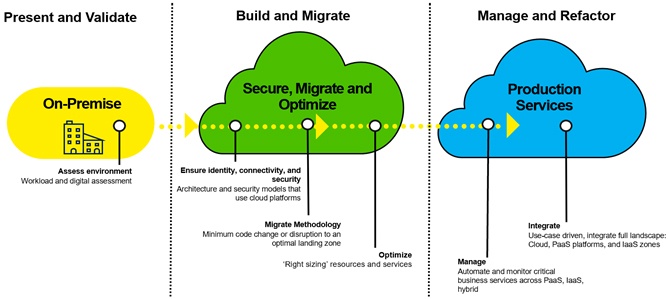Hybrid Strategies and Microsoft Azure
You are here: >Hybrid Strategies and Microsoft Azure
Working with our customers in recent years, it goes without say that we’re always creating or on the pathway to create a cloud strategy. Whether this has been consuming Azure IaaS (Infrastructure as a Service) features or more recently SaaS (Software as a Service) products like Dynamics 365, these have been the real entry point for instigating a shift. The term “hybrid cloud” sometime is lost depending on the audience and for me coming from an Infrastructure background it calls out “tunnels” and “point to point”. Though the definition of hybrid can vary, my view is that the hybrid cloud is a means taking advantage of the benefits of public cloud without having to move everything over. The decision to move applications and services should be based on business value, and a hybrid cloud model creates a platform allowing our customers to make that decision. One common theme to our conversations with customers is that they are still unclear where to start or, more importantly, how to maintain momentum. Maybe simplify this to “The vast array of choice and flexibility can sometimes hinder progress, rather than support it. After all where do you start?”. Organisations want to seize the opportunity that the cloud brings but breaking this down can present challenges that can easily swept away by not doing anything. These challenges will always exist and plotting how we can address these are just as important as adoption and migrating.
Through recent engagements with customers we’ve seen that the need to migrate services “as is” is still a real necessity. For various reason whether this is, exit plans from Data Centers or planning for SQL Server 2008 and Windows Server 2008 End of Support. This approach has been the typical starting point for many when building their hybrid strategies. eBECS approach as depicted below is more around working with our customers to ringfence and assess services for migration using native and ISV solutions and toolsets to present and validate, build, migrate and manage.

There’s a need for a sensible and accelerated approach so customers can realise the value of their cloud environments without a drawn-out migration phase. Therefore, we really to think through building blocks of Identity, Network, Security, Logging and Monitoring which are the foundations of the platform. These foundations are vital and need to be scoped in the initial phases but remember these are continuous task that we must undertake.
eBECS “Path to Hybrid” is about an agile journey to adopt Microsoft Azure as a flexible landing zone which is a mechanical process. But then to layer application innovation with approaches PaaS (Platform as a Service) capabilities that Azure has to offer. The Azure ecosystem is ever evolving as seen on the Azure updates page.
Other key considerations when thinking hybrid strategy include:
- How much is too much cloud, where do we draw the line and control costs?
- What is the best cloud for your workloads, what services will we be consuming? (Virtual Machines, data, APIs, micro-services)
- End user experience, I still want my internal customers to have the feel and experience as if the services are still in the same building?
- How are we going manage, optimise and report on this platform?
- Find the right responsibility and control for your organisation, we don’t have to do it all?
The option to go hybrid has always been available but the message is a lot clearer and we don’t have to move everything. Our customer stories tell us that the hybrid approach and delivering at “cloud speed” gives them options that they would not have achieved if they stayed on-premise.
If you would like to know more about our approach and schedule a workshop, or just share your thoughts on this topic, please contact us at cloud@ebecs.com.
- About Us
- Partners
- Careers
- Contact us
- eBECS and the Microsoft Core Data Platform
- Microsoft Dynamics NAV in Property Management
- Microsoft Dynamics Nav Manufacturing Solutions
- Microsoft Dynamics NAV Cloud pricing
- Drive your Azure Momentum with SQL Managed Instance
- Compare Microsoft Dynamics AX VS NAV
- Microsoft Azure Data Centre Migration Guide
- Microsoft Dynamics 365 Business Central or 365 for Finance & Operations?
- Introduction to Microsoft Dynamics 365 for Finance and Operations
- Microsoft Dynamics 365 Business Central or 365 for Finance & Operations? Thank You
- Microsoft Dynamics 365 Business Central or Dynamics 365 Finance
- Compare Microsoft ERP Solutions
- Compare Microsoft ERP Solutions, Dynamics NAV vs Dynamics 365 Business Central
- Microsoft Dynamics 365 Business Central Price
- Compare Microsoft ERP
Categories
- AI (3)
- Azure (2)
- Business Insights (1)
- Canvas Apps (1)
- Common Data Service (2)
- Crisis Communication (1)
- CRM (3)
- Customer Data Platform (1)
- Customer Insights (1)
- Data Analytics/BI (29)
- Data Management (1)
- Data Warehouse (1)
- Dynamics 365 (33)
- Dynamics 365 Finance (1)
- Dynamics 365 Sales Insights (1)
- Dynamics 365 Supply Chain Management (1)
- Dynamics AX (50)
- Dynamics CRM (22)
- Dynamics Field Service (10)
- Dynamics NAV (10)
- Dynamics Project Service Automation (PSA) (15)
- eBECS (4)
- eBECS Marketing (1)
- eBECS Policies (1)
- ERP (2)
- Internet of Things (IoT) (15)
- Master Planning AX (4)
- Microsoft 365 (1)
- Microsoft Lifecycle Services (4)
- Power Apps (4)
- Power Automate (3)
- Power BI (1)
- Power Platform (6)
- Power VIrtual Agent (1)
- PowerApps (2)
- Project Service Automation (2)
- Quality Management (1)
- Sales (1)
- Surface Hub (3)
- Top Tips (1)
News
Upcoming Events - Register Now
Join our list
eBECS will invite you to webinars, events and keep you up to date with relevant news. You can unsubscribe at any time.









